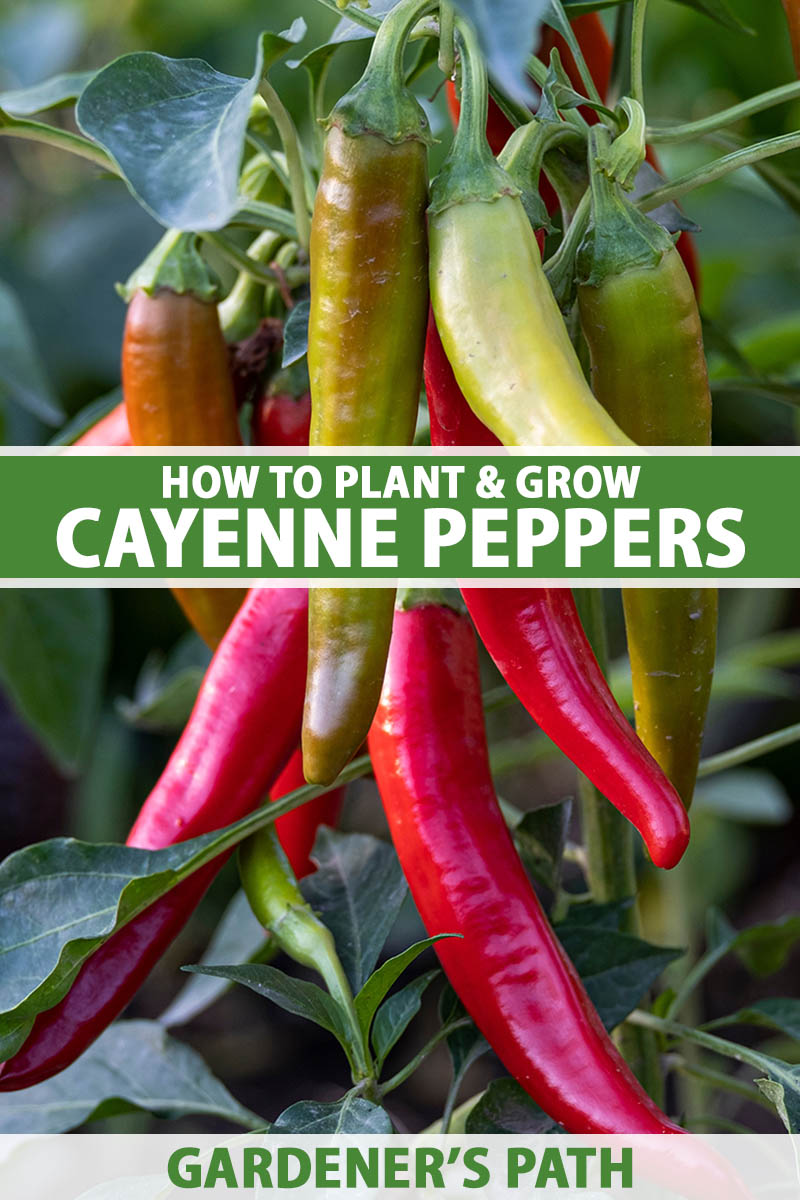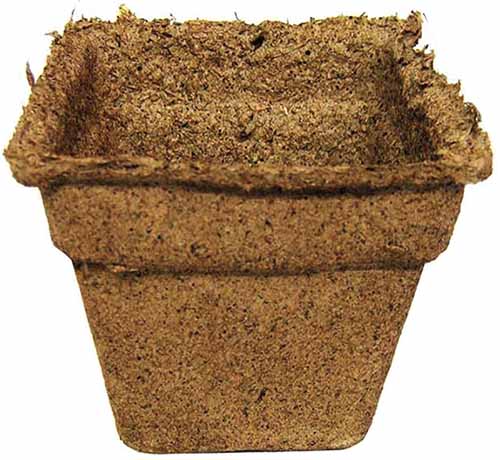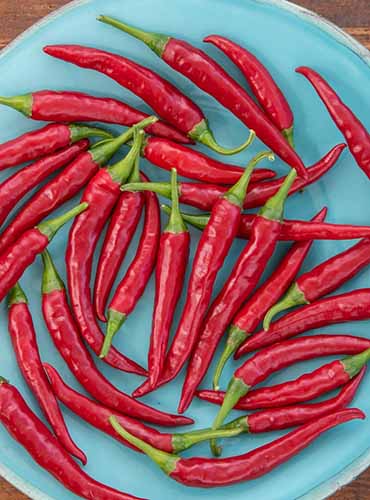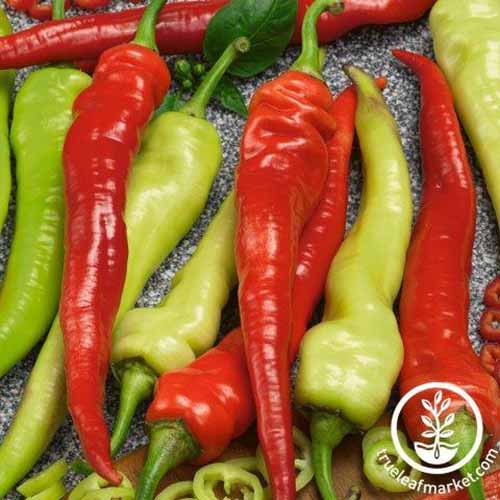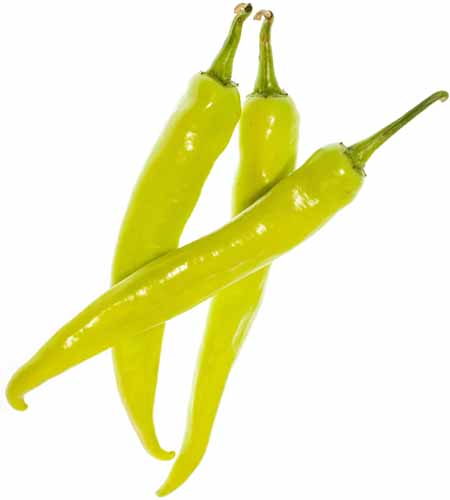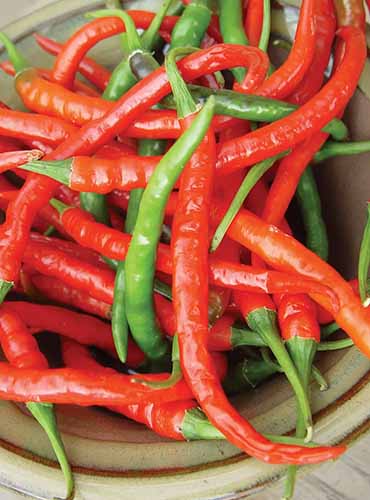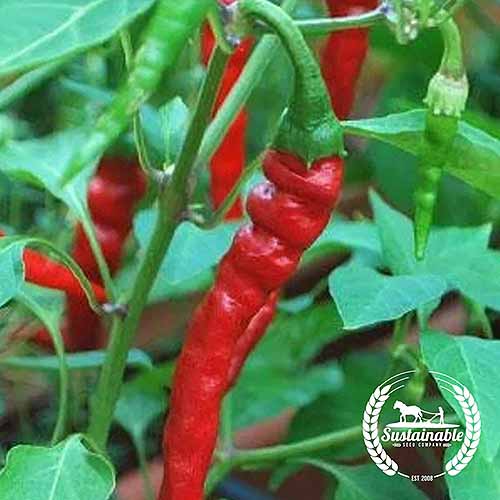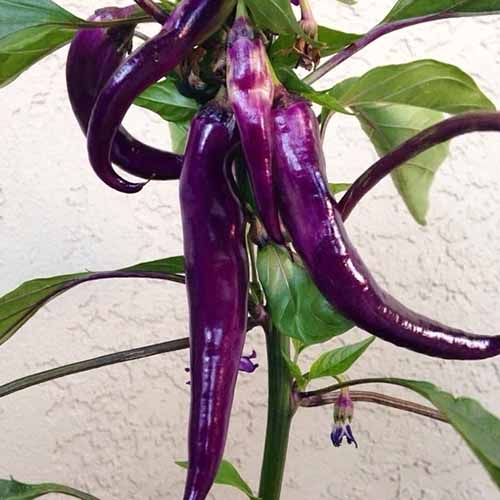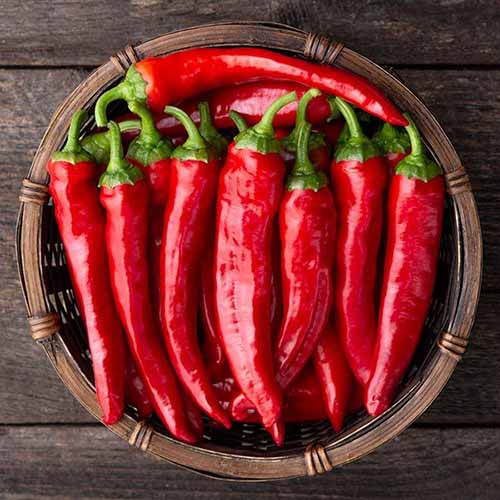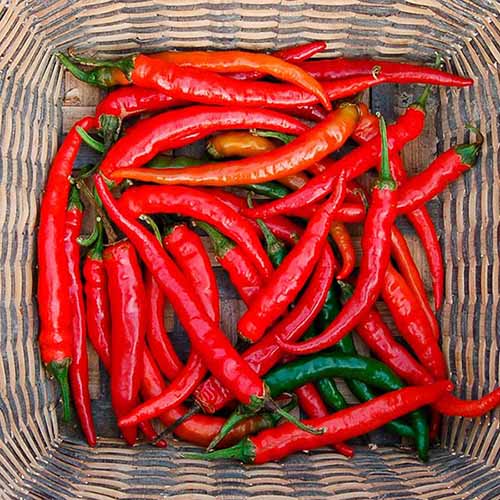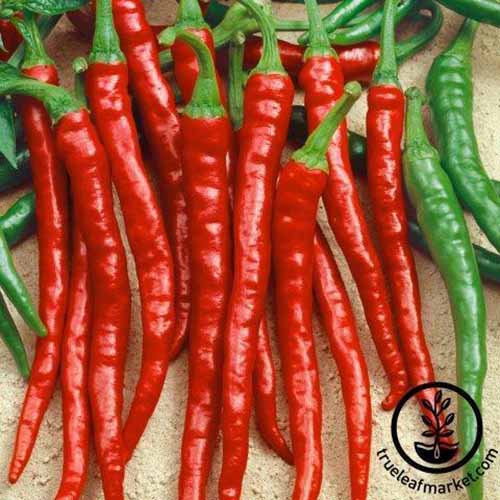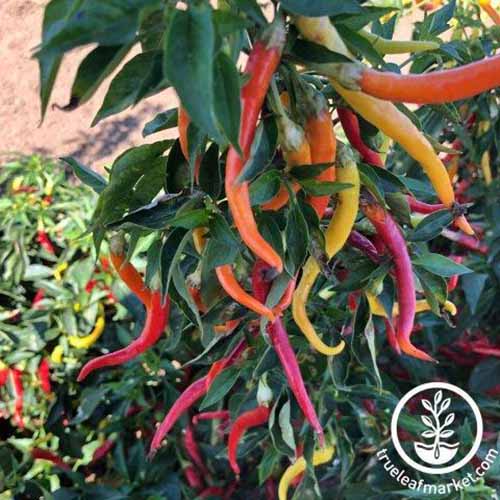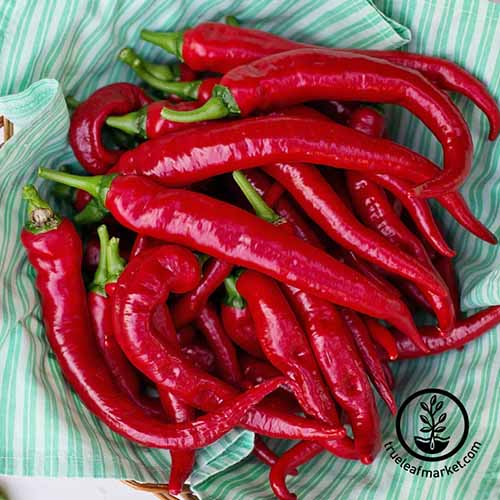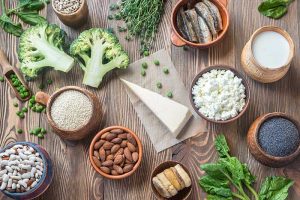Capsicum annuum ‘Cayenne’
Have you ever wondered where those flakes come from in those little packets that you use to top your pizza? Or that marvelous red powder that we use to flavor so many dishes?
Or how about what gives Crystal and Frank’s RedHot sauces their zing?
They all come from a group of chilis known as cayennes.
They’re not just for drying and sauces, though using them that way is extremely popular. Cayennes are also delicious eaten fresh. That is, if you like things hot.

We link to vendors to help you find relevant products. If you buy from one of our links, we may earn a commission.
The citrusy, smoky, heat comes on fast and leaves just as quickly, which makes it more universally popular than those peppers with a lingering heat that builds and builds until you can’t take it anymore.
If you’re looking to add these long, lovely chilis to your garden, here’s what we’re going to discuss to make that happen:
What You’ll Learn
Before we talk about soil, water, sun, and all that, we should clarify what exactly we’re talking about when we say “cayenne.”
What Is Cayenne?
“Cayenne” can be used as a catch-all term for a group of small red peppers in the Longum group.
It’s also a term for moderately spicy dried peppers or powder. Technically, there is a ‘Cayenne’ cultivar that is considered the standard, but most people refer to “cayenne” as a style.
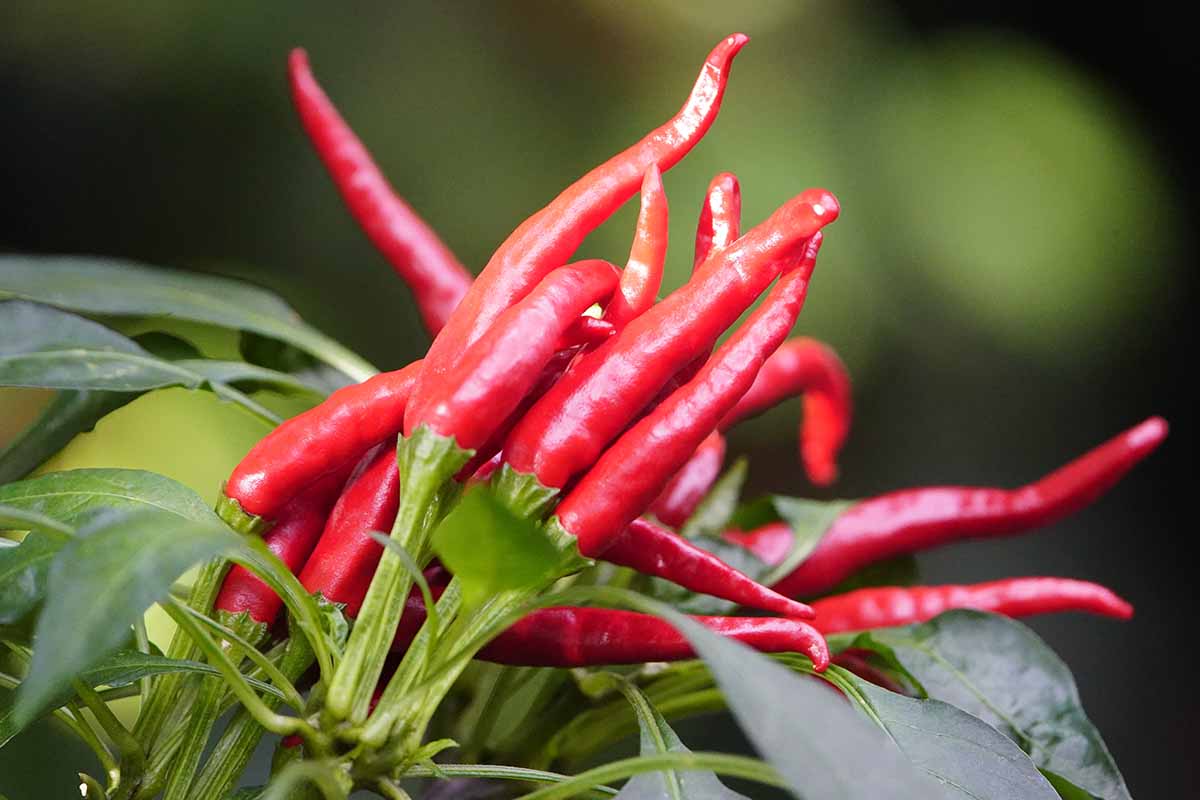
Any pepper that is red, two to four inches long, narrow, slightly curved, and moderately spicy might be called cayenne, and there are dozens of cultivars. Thai peppers are considered cayennes, for example.
Cayennes are generally about five to 10 times hotter than a jalapeno at 30,000 to 50,000 Scoville Heat Units (SHU). But there are some cultivars that are far milder and a few that are much hotter.
You can also influence the heat level with the length of time that you let the fruit mature.
If you’d like to learn more about the SHU system and how heat is measured, as well as how and why the capsaicin in the fruits causes a burning sensation in our bodies, visit our guide to growing hot peppers.

Speaking of capsaicin, that’s the chemical that produces what we perceive as spicy heat, a chemical irritant that the plant produces to keep predators away.
It’s what pepper spray is made of and it is produced in high concentrations in the pepper’s placenta, which is the whitish stuff that holds the seeds.
Cultivation and History
The name “cayenne” purportedly comes from the city in French Guiana where it was first cultivated.
Or maybe the town was named for the pepper. It’s not really clear, though they’re certainly related somehow.
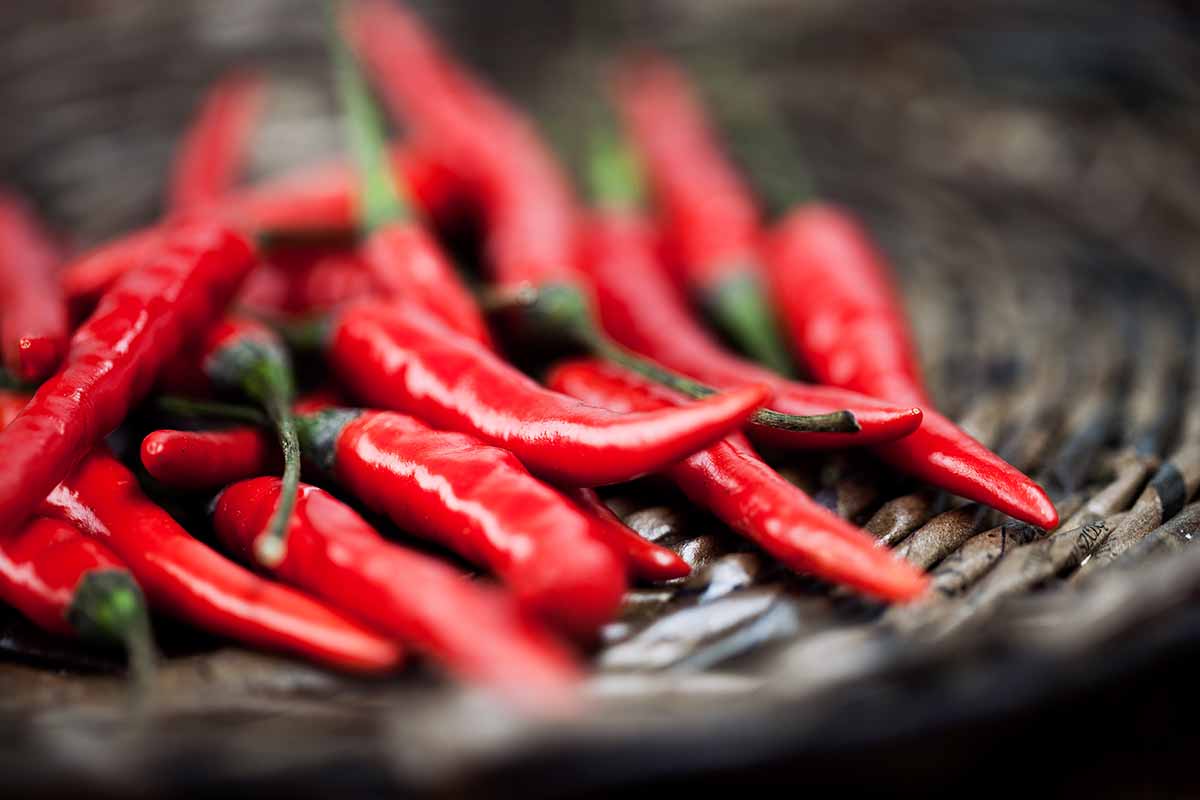
What we know for sure is that botanist and herbalist Nicholas Culpeper referred to a “cayenne pepper” in “Culpeper’s Complete Herbal” in 1652.
Cayenne, French Guiana, was named in 1777. So it seems like the city might be named after the chili and not the other way around.
Culpeper believed the “cayenne pepper” could promote digestion and health, and claimed that it originated in India, though all peppers truly originated in South and Central America.
He warned that they were so spicy that they caused a “blister in the mouth and throat” and the “vapour from them occasions sneezing, coughing, and even vomiting.”
Cayenne peppers were first offered in the seed trade by Joseph Breck and Son in 1883.
Cayenne Pepper Propagation
Propagating cayenne peppers from seed is easy, but you need to plan well ahead. If you don’t have the time or space, you can usually find starts in pots at most well-stocked nurseries.
Let’s go into a little more detail for both options.
From Seed
Cayenne peppers – in fact, all peppers! – are such a dream to grow from seed. The seeds are easy to extract from the fruit or you can purchase them for a song, and they’re large enough to handle without much trouble.
The one thing that has changed my growing game is remembering to sow more seeds than I think I’ll need. I always place two or three seeds per pot and then just thin the seedlings out, if needed.
Or, you could sow in twice as many pots as you need. You can always give away extras to the neighbors.
While pepper seed germination is fairly reliable, it takes a while. If you start your cayenne pepper seeds indoors too late and then find out that they didn’t germinate, you might be out of luck for the season because you’ve run out of time.
To start, gather your supplies and prepare about eight to 12 weeks before the last predicted frost date in your area.
Fill four-inch pots with seed-starting mix. I like to use biodegradable pots because they’re good for the environment and they reduce the risk of shock when you transplant.
If you’d like to grab some, Arbico Organics carries four-inch, square CowPots in quantities of 12, 180, or 450.
If you decide to use your own cayenne pepper seeds, scrape them out of the center of a fruit and remove any of the placenta that remains attached.
You can plant them fresh or let them dry on a paper towel to store for later.
Whether purchased or harvested yourself, you should give the seeds a quick rinse in a 50:50 mix of hydrogen peroxide and water. This kills any pathogens that might be hiding out.
If you want to test the viability of your seeds, place them in a bowl of water. Those that sink are good to go. Those that float might not be viable. Feel free to toss any floaters out or be sure to double up on those seeds.
Sow the seeds a quarter of an inch deep and gently water the medium, taking care not to disturb the soil.
Cayenne pepper seeds need warmth to germinate, so place them on a heat mat unless you can maintain the soil temperature at around 70°F otherwise.
The seedlings need exposure to at least eight hours of sunlight. More is better, up to 12 hours. If you can’t provide that, give them supplemental lighting.
Depending on the wattage, you’ll generally want to place the lights just above the pots. As the seedlings emerge, you’ll need to move the lights further and further away.
The cayenne plants will tell you if they’re unhappy. The seedlings will be leggy if they don’t have enough sun and the leaves will burn, with yellow or brown patches, if the light is too close.
Keep the soil moist but not wet as the seeds germinate. Don’t forget that biodegradable pots dry out quickly and a heat mat increases evaporation as well, so you’ll need to stay on top of watering.
Germination can take weeks, so don’t go tossing everything out and writing off cayennes forever if nothing happens after a week or two.
If at any point flowers start to form after seedlings have sprouted, pinch those right off.
Once the seedlings are about six inches tall and the last predicted frost date has passed, you can start the hardening off process.
This takes about two weeks because cayenne pepper seedlings are extremely sensitive to cool temperatures. You don’t want to rush it and risk losing your seedlings after you’ve put in all this work, so be patient.
On the first day, take the seedlings outside and place them in a protected area in full sun for 30 minutes. The next day, leave them out there for an hour.
Keep adding 30 minutes each day for two weeks. Now you can plant them in the ground or into a larger container.
Transplanting
Once the last predicted frost date has passed and the soil is above 60°F, you can put those cayenne peppers into the ground.
You can even do it a bit earlier than this if you can cover the seedlings with protective growing plastic or place black plastic or mulch around the plants to raise the temperature.
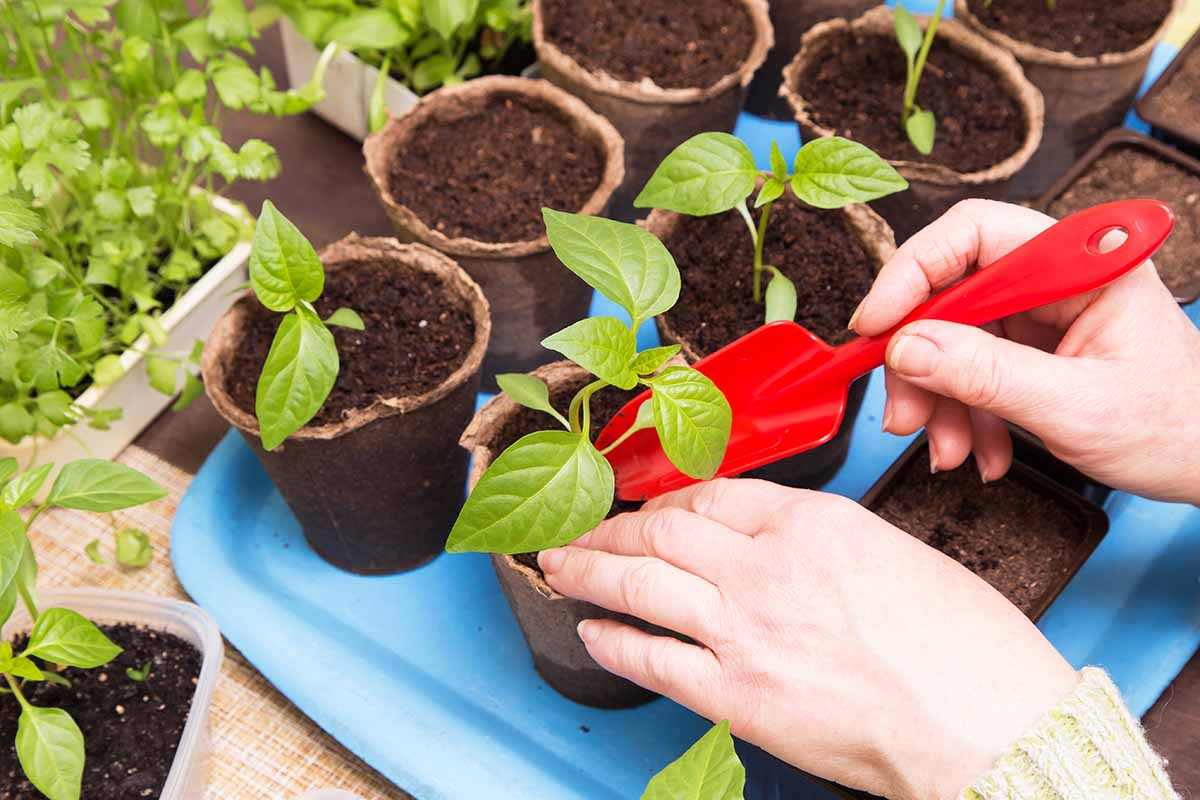
Dig holes a foot apart about the same size as the growing container. If you have heavy soil, loosen it up a bit with some well-rotted compost, digging at least a foot down and wide.
You can also grow your cayenne chilis in larger containers. That way, if you need to move them out of bad weather, you can.
Since they’re perennials, you can enjoy cayennes for years and years this way if brought indoors. If you decide to pot them up, a two-gallon container is a good size per plant.
Choose a heavy pot that won’t tip over when the plant is mature, and one that has good drainage. If you reuse a container, be sure to wipe it out with soapy water or sanitize it using a bleach solution.
Plant a cayenne pepper in each hole you made and firm the soil up around them. Water well to settle the soil and add more soil, if necessary.
If you’re using a biodegradable pot, you don’t have to remove the plant from the pot, but rip away or trim any excess container material that sits above the ground.
If temperatures even flirt with dipping to 50°F, cover the seedlings to protect them or move them indoors if you have them in containers.
How to Grow Cayenne Peppers
In my experience, the trick to growing hot, juicy cayenne peppers is high temperatures with lots of moisture. Or maybe it’s low moisture and high temperatures. Confused?
So, all chilis produce that marvelous capsaicin in response to stress. Remember, it’s part of the plant’s defense system.
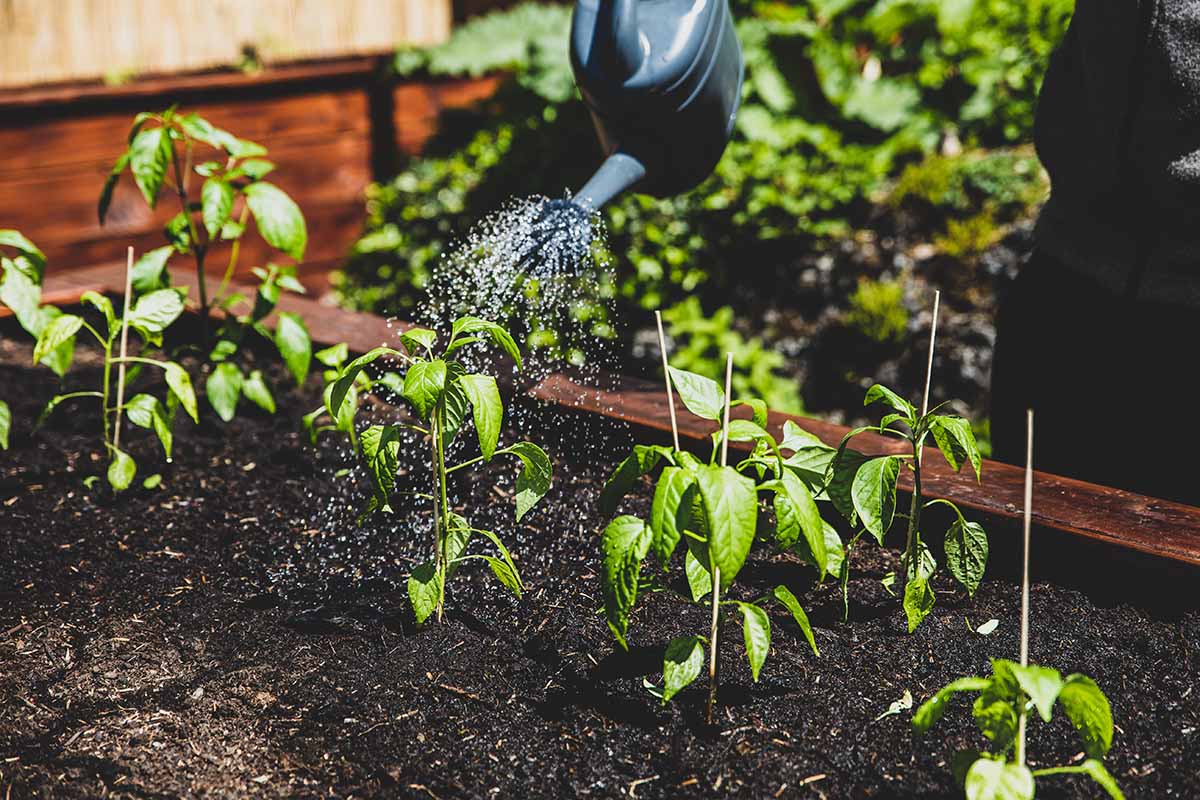
You can stress the cayenne pepper plant by either reducing moisture to the point where the leaves start to droop, or you can expose them to extreme temperatures.
Since it’s easier to control moisture than temperature, that’s the direction most people go in.
But here’s the trick: You don’t want to expose the plant to water stress until the fruit has set.
You might read elsewhere online that you should let the leaves start to droop before you water your cayenne peppers again, but don’t take it that far. Just reduce the amount you typically water by a third or so.
In my region, the temperatures rarely climb above the mid-80s, so I reduce the amount of water I give my plants. I wait until the leaves are notably droopy before I water.
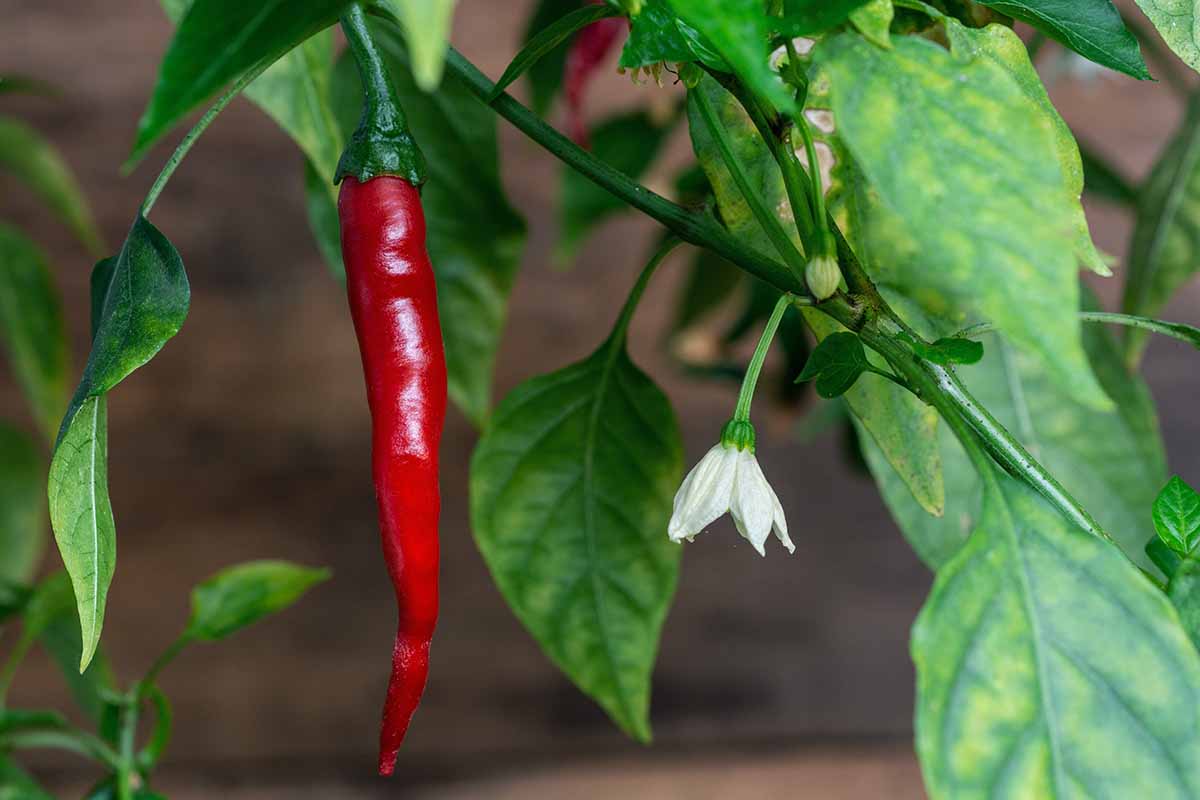
I live in a region with a short growing season in that we only have a month or two when temperatures regularly climb above the 70s. And peppers like it hot!
So, I place grower’s plastic over my cayenne peppers and close it up on cooler days to trap the heat.
I also place black plastic around the plants in the ground to heat up the area. With this system in place, I can plant a month earlier than my neighbors and grow a month or two longer.
I was plucking my last chilis in November last year when everyone else had tossed their plants in early October.
Growing Tips
- Plant in full sun, the more the better!
- Reduce water after fruit set.
- Cover plants in clear plastic if temperatures drop below 70°F.
Pruning and Maintenance
There isn’t much you need to do to maintain cayenne plants.
If they seem a bit floppy, you can stake them or put a cage around them, though I find cayennes are usually fine without support, except for the cultivars with exceptionally large fruits.
We’re going to talk about some of those, next.
Cayenne Pepper Cultivars to Select
Many people imagine that there is just one “cayenne” pepper, but there are lots in this group, from super hot ‘Ring of Fire’ to pretty ‘Purple.’
Here are a few of the best:
Buena Mulata
It’s not clear where it originated, but modern ‘Buena Mulata’ seeds come from seed collector and artist Horace Pippin who saved and traded them in the 1920s.
From there, Dr. William Woys Weaver, an expert on rare seeds, held onto a few and introduced them to the market.
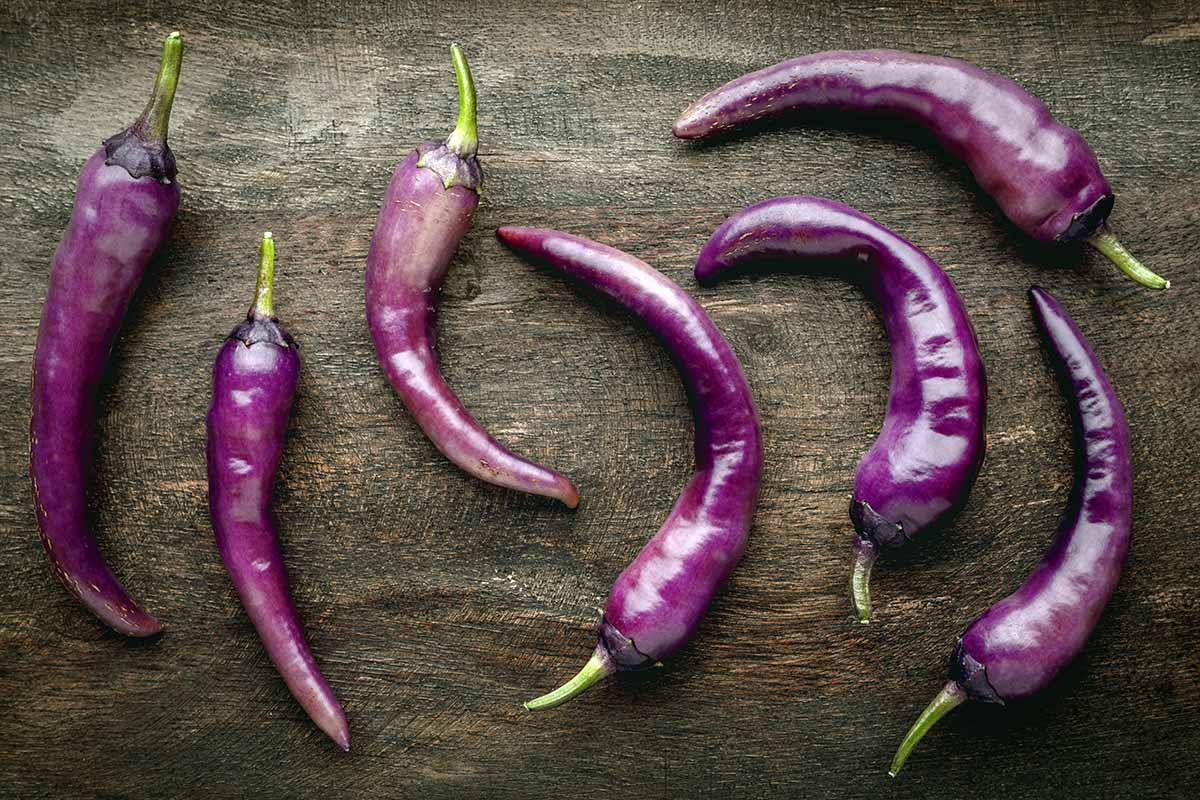
The four-inch fruits are beautiful, but the plant isn’t as highly productive as the OG. That just makes them all the more precious.
This is one of my favorite cayennes and I grow it every year. It’s a stable cultivar, so you can save your own seeds and enjoy the kaleidoscope of color over the growing season.
The fruits start out green, transition to yellow-orange, turn red, and finally settle into their mature striking purple hue. With each color transition they have a different flavor.
You can pluck the unripe fruits if you want a grassy nibble with just a hint of heat.
Or let them fully ripen over about 85 days for that jewel-like purple, which is even deeper and bolder than the ‘Purple’ cultivar.
Dragon
‘Dragon’ fruit is shorter and thinner than that of the traditional cayenne cultivar, but equally as spicy.
It was bred by combining the standard cultivar and a Thai pepper, creating a treat with a smoky bite.
The three- to four-inch fruits are ready in about 60 days, so what are you waiting for? Visit Burpee for a pack of 25 seeds.
Espana
The long red fruits of ‘Espana’ can reach up to seven inches long in just 65 days. This hybrid cayenne is much milder than other cayennes, coming in closer to a jalapeno.
The flesh is also slightly thicker than your standard-issue, which I think makes it ideal for roasting on an open flame.
Bring home a 300 milligram packet, or a quarter-, one-, or four ounce-package from True Leaf Market.
Golden
With beautifully smooth, golden yellow skin, ‘Golden’ cayenne is a sight to behold.
It has the same heat as the standard cayenne, so you can use it anywhere you want a burst of yellow. Imagine these peppers dried or ground into a powder. Pure gold.
Let them mature fully to develop the best color and heat. It takes a bit more time for the six-inch-long fruits to mature, so you’d best get started.
Pick up your seeds at True Leaf Market. They carry 500 milligram, quarter ounce, ounce, four ounce, and pound quantities.
Joe’s Long
At up to a foot long, the fruits on ‘Joe’s Long’ cayennes are longer than almost any other cayenne cultivar.
They’re about as big in circumference as a pinky finger at the stem end and 10 inches long, so you can have a lot of cayenne bang for your buck.
Their long, thin shape also makes them perfect for drying, and each 24-inch plant gives you lots of fruits to work with.
‘Joe’s Long’ is an heirloom cayenne introduced by Joe Sestito from Troy, New York, after he obtained an Italian plant that had been popular with the Toronto seed-saving community for several years.
Dr. Carolyn Male, an active member of Seed Savers Exchange, gave it to the non-profit in 1996.
Long Red Slim
With six-inch-long, extremely narrow fruits like bright red pencils, this cayenne cultivar lives up to its name.
‘Long Red Slim’ has heavily wrinkled skin, and the fruits might curl and twist, making them an interesting addition to the kitchen, either dried or in a big bowl.
They’re ready to devour in 75 days, and you can pick up 100 seeds from Burpee. Bring on the heat!
Long Red Thin
You could easily confuse ‘Long Red Thin’ with ‘Long Red Slim,’ and they do look extremely similar.
Like its similarly-monikered friend, it has narrow, six-inch-long fruits with heavily wrinkled skin. They, too, will curl and twist.
The main difference is that they’re slightly milder, though still not what you should consider mild.
They take 70 days to mature, but the heat develops fairly early. Once the red color starts to develop, you can pop them off the plant and dig in. Or let them develop fully for more heat and color.
Pick up 250 milligrams, one ounce, or four ounces of seed at True Leaf Market.
Orange
Take the original cayenne, use your magic wand to turn it bright orange, iron out the wrinkled skin, and add just a little bit of extra heat and citrus. Voila! You’ve got ‘Orange’ cayenne.
The six-inch cayenne peppers grow on a plant that is a bit larger than most other cultivars at four feet tall. That means tons and tons of gorgeous peppers!
The fruits tend to be extremely uniform, which makes drying or chopping easy-peasy.
Head on over to Eden Brothers and bring home a small packet or ounce of seeds and get started.
Purple
Who said a cayenne pepper has to be red? If you love a good purple veggie, with all its nutritious deliciousness, pick ‘Purple.’ It’s pretty enough to be appreciated as an ornamental.
The fruits start out green, gradually transition to red, and finish off purple when they’re mature, at which point they reach about six inches max in length on a three-foot-tall plant.
Visit Eden Brothers for a packet or ounce of seeds.
Red Ember
Glowing in the garden, ‘Red Ember’ is more flavorful, early maturing, and high-yielding than the traditional cayenne.
Brought to us by Janika Eckert, a breeder at Johnny’s Seeds, it won in the All-America Selections veggie category in 2018.
It has thicker flesh than other cayennes, which contributes to the delicious flavor of the four-inch fruits.
High Mowing Seeds carries this excellent cultivar in a variety of packet sizes and in bulk.
Ring of Fire
‘Ring of Fire,’ sometimes written ‘Ring-O-Fire,’ is an early maturing cayenne plant with bright red, four-inch-long fruits.
These chilis are on the hotter end of the scale at 50,000 SHU. If you’re looking for heat, this is the one to go with.
The fire-engine-red peppers have heavily wrinkled skin on an 18-inch plant that is covered in fruits.
Cue up the Johnny Cash, put on your gardening gloves, and get ready to plant your seeds.
You can get a range of quantities at High Mowing Organic Seeds.
Ristra
‘Ristra’ is no shrinking violet. The two-foot-tall shrub produces piles of cayenne peppers that are each nearly a foot long.
They aren’t straight as a ruler, though. They take on an appealing twisting and curling shape, and they’re quite a sight strung up for drying.
Not the hottest cayennes, they are right there in the middle of the heat scale, with the strongest heat once the peppers are completely red.
Even if you let them ripen fully, much like modern jalapenos, some will be spicy and some will be mild and sweet. It’s an adventure!
Visit True Leaf Market to pick up a 300 milligram packet, a quarter-ounce, or an ounce package of seed.
Sweet
‘Sweet’ has extremely thin skin, perfect for drying. Plus, the cayenne peppers are extremely long at 12 inches on a relatively small two-foot shrub.
Perfect for someone who likes the flavor of cayenne but doesn’t want all that spice, instead of offering up pure heat, this cultivar is a lot milder with a touch of sweetness.
The straight, cherry-red fruits are great looking too, especially hanging in a group. Shove a needle through the top and thread a bunch together to use them as a display.
True Leaf Market carries this sweet option in a variety of packet sizes.
Sweetness
Have you ever accidentally set off a fire alarm? There’s nothing on fire in your house; it’s just a false alarm. That’s this pepper.
It looks hot. It has that classic cayenne shape. But it’s mild. As in, very mild.
On the good ol’ Scoville scale, it comes in at a whopping zero. These taste just like sweet peppers but they look like they pack a wallop.
Each chili is about five inches long and twisted, and you wouldn’t be able to pick them out of a cayenne lineup with certainty based on looks alone.
While they’re delicious if used as you would any other sweet pepper, imagine putting them on a veggie tray and daring your friends to dig in.
They aren’t just a novelty, though. The sweet, smoky flavor is worth having around dried or fresh.
Definitely give these a try. Visit True Leaf Market for a 300 milligram, quarter ounce, or ounce packet.
Thick
I’ll give you one guess as to what makes this cayenne stand out. Yep, it’s the thickness.
It’s extremely thick, twice as wide as any other cayenne, but with the same five-inch length. These are the widest cayenne chilis you can grow.
The three-foot-tall shrub produces lots of fruits that go from dark green to fire-engine red. They’re middle-of-the-road spicy, with enough heat to punch up dishes but not so much that you’ll be crying and gasping for the milk.
You can find seeds available at True Leaf Market in a variety of packet sizes and in bulk.
Managing Pests and Disease
Because of all that fantastic capsaicin, most mammals won’t come near your chilis. But birds will.
I find that they are less interested in the cayenne types unless they fall from the bush. Maybe the shape is too awkward for them to get a good bite out of?
Whatever it is, some netting placed right as the fruits start to change color is enough to deter them.
Now, insects on the other hand…
Insects
Not only do they spread disease, but it seems like invertebrates are totally unbothered by capsaicin. Darn!
Aphids, cutworms (and other larvae), flea beetles, and spider mites are the most frequent visitors.
If you see holes or yellowing leaves, or any other sign of a pest issue, visit our guide for a full explanation of 13 pepper pests and how to get rid of them.
Disease
Although cayennes tend to be fairly resilient and disease-free, those pathogens that do infect them can really cause problems. Let’s talk about bacteria first.
Bacterial Spot
Not that I like any disease, but I especially dislike bacterial spot. It doesn’t play fair.
The early symptoms of small brown spots on the leaves are pretty indistinct. They could be anything, really.
Then, as the disease progresses, those spots become larger and raised. You’ll see them on both the fruits and the leaves.
The other reason I hate it is because there is no known cure. Caused by the bacteria Xanthomonas vesicatoria, X. euvesicatoria, X. gardneri, or X. perforans, it spreads through water and dead plant material, and it can live in the soil.
Your best bet at avoiding it is to rotate your crops. There are many diseases you can avoid using crop rotation, so don’t put anything in the nightshade family in the same place more than once every four years.
You should also avoid splashing water on the plants and be careful to water at the soil level.
Bacterial Wilt
Another bacterial disease, bacterial wilt is caused by Ralstonia solanacearum. This pathogen can live on all nightshades, including weeds such as black nightshade (Solanum nigrum).
It causes the plant to rapidly turn yellow, wilt, and die. And there’s nothing you can do about it besides pull and dispose of the plants. Like bacterial spot, the pathogens can live in the soil for a long time, so crop rotation is crucial.
It also lives in the soil and dead plant material, and can spread in water.
Blossom-End Rot
Blossom-end rot looks like a symptom of disease. There’s even “rot” in the name. But it’s a physiological condition that develops when the plant misallocates calcium.
Many gardeners assume that you simply need to add more calcium to the soil and the problem will be solved.
That makes logical sense, since it occurs when there isn’t enough calcium in the fruits. But it’s usually caused by a problem that makes it difficult for the plant to develop a robust root system and take up water.
This could be anything from cold soil to root damage to drought. You won’t even know there’s a problem until the fruits start to develop and the end turns brown and soft.
We have a guide to blossom-end rot in tomatoes that you may want to read. The cause and available solutions are all the same with cayenne peppers.
Feel free to check that out to learn how to avoid this problem in the future, since there isn’t anything you can do once the fruits are symptomatic.
Mosaic Virus
Despite their names, cucumber (CMV) and tobacco mosaic virus (TMV) both infect pepper plants, including cayennes and both are spread by pests that feed on nightshades like aphids and thrips.
Once the pests feed on the cayenne plant, it’s too late. The pathogen has moved into the plant’s system. So, it doesn’t help to eliminate pests once they’ve been feeding. You need to keep them away in the first place.
The best way to do this is with fine netting, but reflective mulch helps, too.
Once the disease takes hold, the leaves of the plant will develop unusual yellow, light green, or dark green mottling. The plant’s growth will be stunted. Plus, now that it’s infected, the disease can spread to other nightshades as well as cucurbits.
You’ll need to pull and safely dispose of any infected plants, because there is no cure and it can spread rapidly.
Harvesting
Once the cayenne peppers attain their mature color, you can harvest them.
If you want the hottest cayennes possible, grab them off the plant promptly once they reach their full size and mature color.
This typically happens about 50 days after the fruit sets, but you can also check the seed packet to see what size the fruit should grow to.
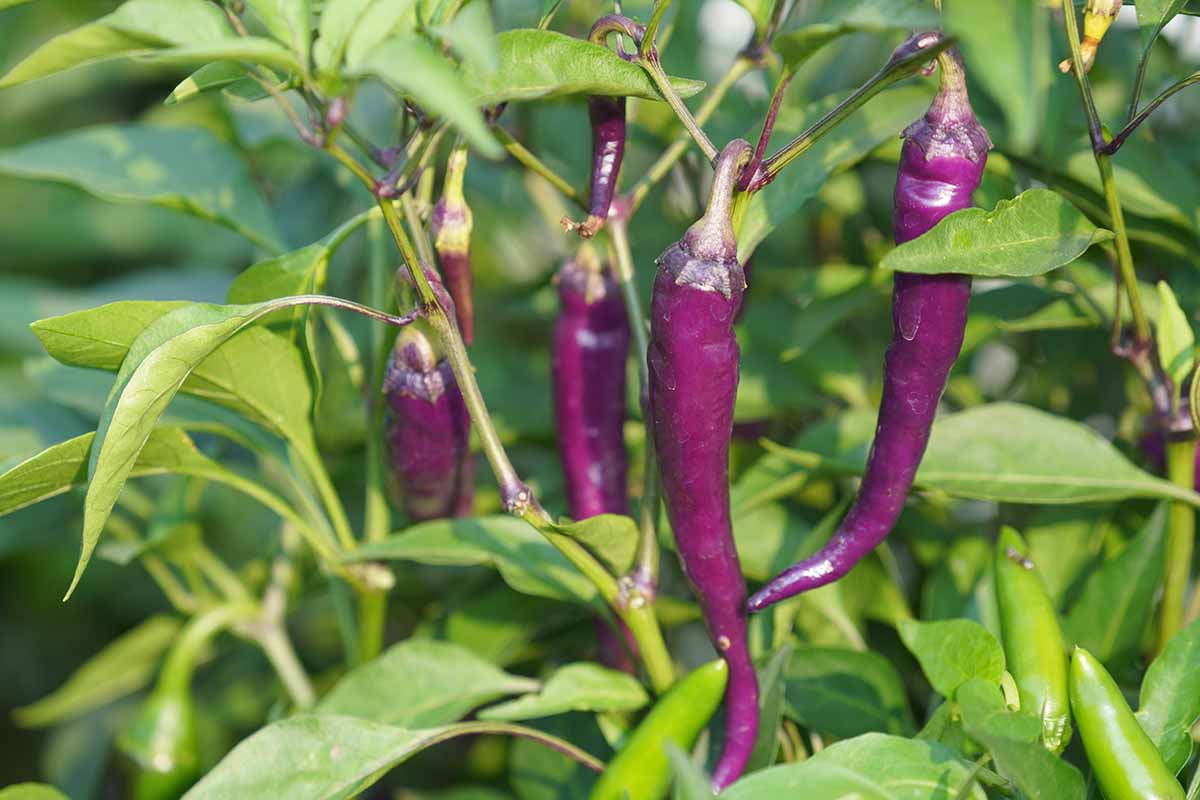
If you leave chilis on the plant longer, capsaicin levels start to drop. If you pluck them too young, the capsaicin levels will also be lower. If you prefer a milder cayenne, keep that in mind.
To harvest, gently pull a cayenne pepper away from the plant by gripping the top or the stem attached to it. You want the cap to remain attached because the fruit will last longer that way.
If you intend to dry them immediately in a dehydrator, you could go ahead and pull them off the plant, leaving the cap behind – just be careful not to break the branches!
Preserving
Cayennes are perfect for drying. Hang them in bunches by leaving a bit of stem on them when you harvest or poke a needle and thread through the top and hang them to dry.
You can also plop them whole or sliced into a dehydrator.
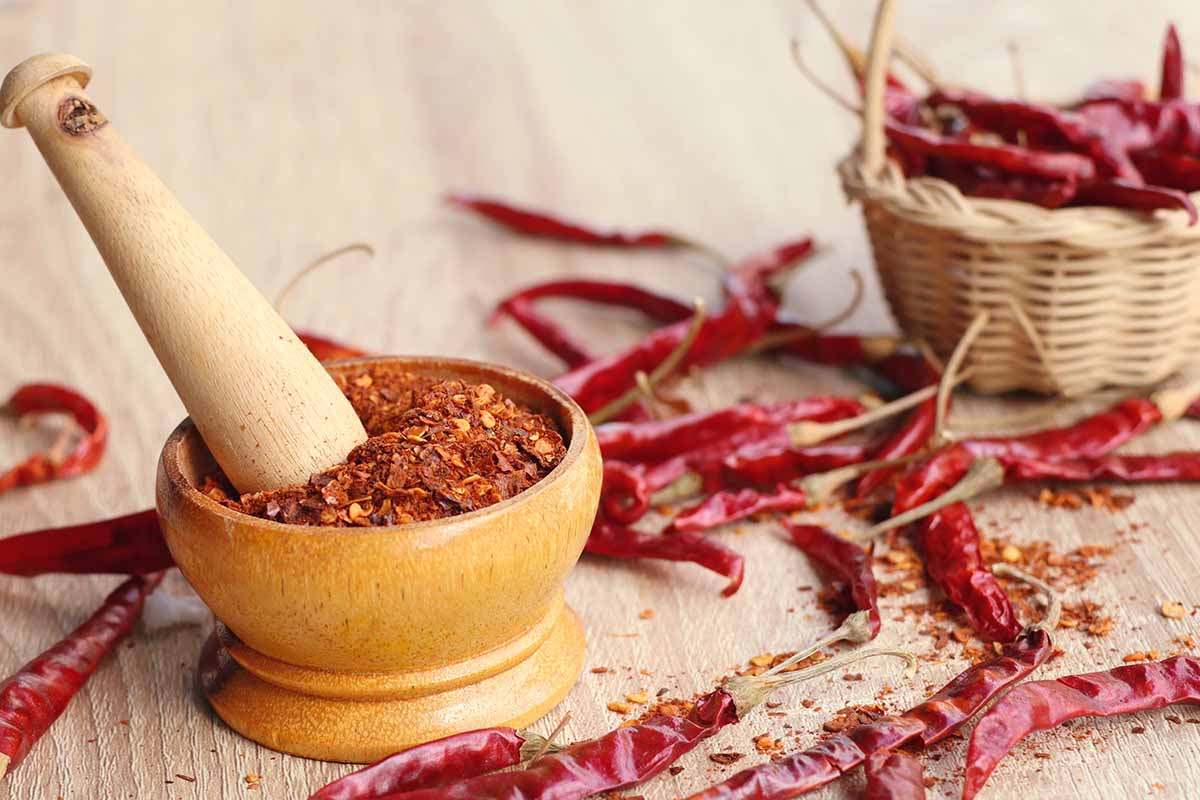
Dehydrate at 125°F until they feel dry and hollow. This takes anywhere from four to 10 hours, depending on how large your pepper pieces are. Whole peppers take the longest.
Cayenne peppers can also be pickled, frozen, or packed in oil.
Recipes and Cooking Ideas
I think cayennes are perfect wherever you want some smoky heat that isn’t going to cause tears and snot to run down your face.
Comfort food classics like chili, pulled pork, mac and cheese, and etouffee are all good candidates.
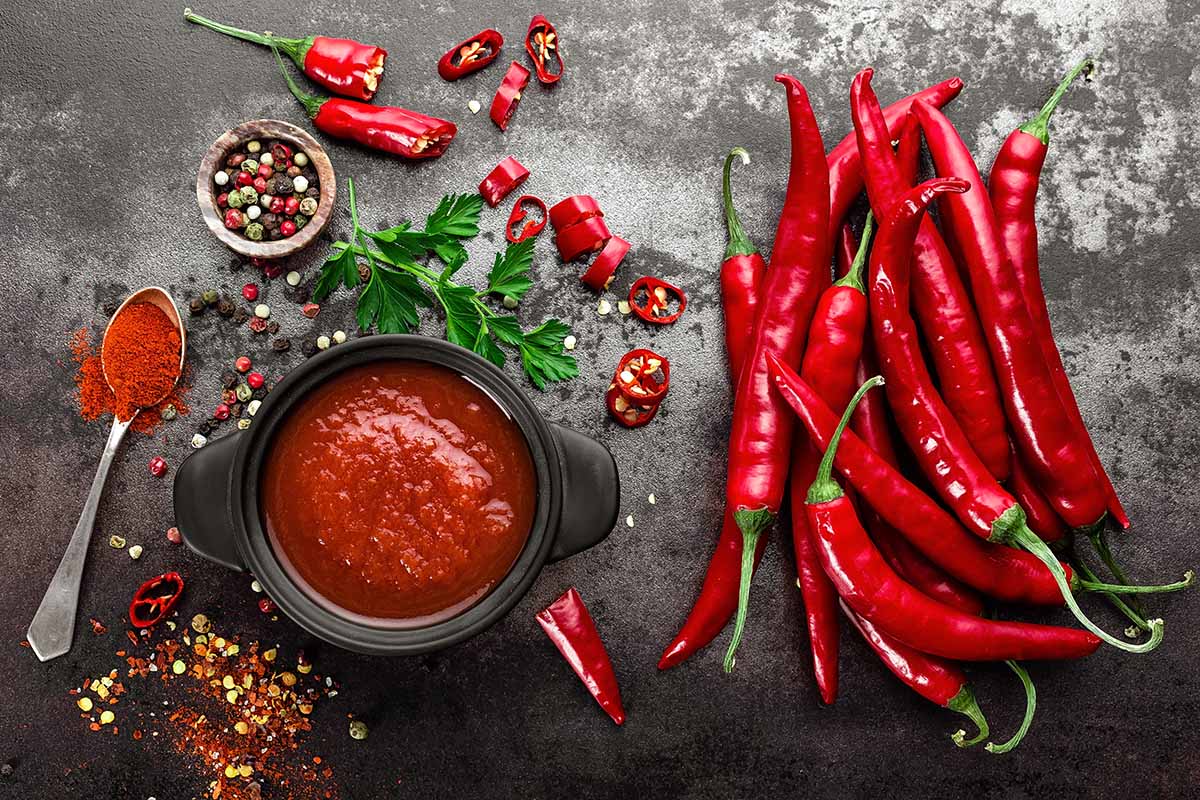
They work well in sweet dishes, too. One of the best macarons I ever had was made with the ‘Purple’ cultivar. Or add them to a honey vinaigrette. Get the recipe at our sister site, Foodal.
Quick Reference Growing Guide
| Plant Type: | Short-lived perennial vegetable | Water Needs: | Moderate |
| Cultivated in: | South America | Maintenance: | Low |
| Hardiness (USDA Zone): | 8-11 | Tolerance: | Heat |
| Season: | Summer | Soil Type: | Loose, rich |
| Exposure: | Full sun | Soil pH: | 6.0-7.0 |
| Time to Maturity: | About 90 days (cultivar dependent) | Soil Drainage: | Well-draining |
| Spacing: | 1 inches | Companion Planting: | Basil, chives, dill, fennel, garlic, marigolds, nasturtiums, onions, petunias, sweet alyssum, yarrow |
| Planting Depth: | 1/4 inch (seeds), depth of root ball (transplants) | Avoid Planting With: | Brassicas, other nightshades |
| Height: | 2 feet | Family: | Solanaceae |
| Spread: | 18 inches | Genus: | Capsicum |
| Growth Rate: | Moderate | Species: | Annuum |
| Pests & Diseases: | Aphids, birds, cutworms, flea beetles, spider mites, thrips, tomato hornworms; bacterial spot, bacterial wilt, blossoms end rot, mosaic virus | Group: | Longum |
Spice Things Up
The shape and thin skin makes them easy to dry and each fruit packs a punch, but cayennes didn’t become so popular based on their heat and shape alone.
They have a complex flavor and with enough variety to offer up oodles of choices, whether you want something mild and sweet or hot as hades.
How do you like to use your peppers? Share with us in the comments!
Want to explore the Capsicum genus further? We have several guides to growing peppers that will be right up your alley. Here are just a few:
